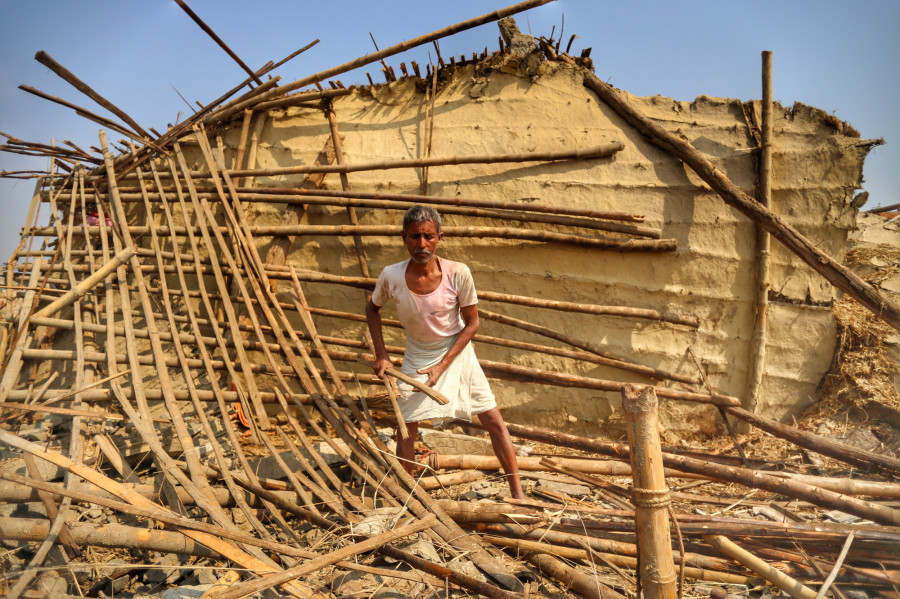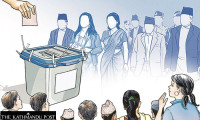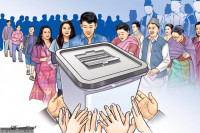National
As politicians promise money, survivors say they’ve heard it all before
Survivors of the disaster who spent their first night under the open sky say they are desperately in need of relief, not announcements and promises of help from politicians.
Anup Ojha & Laxmi Shah
After witnessing a devastating windstorm on Sunday night, Bara and Parsa districts have seen a whirlwind of visits by high profile political leaders. But survivors of the disaster who spent their first night under the open sky say they are desperately in need of relief, not announcements and promises of help from politicians.
Twenty-seven people died and thousands were injured when a powerful windstorm tore through villages of the two districts in the Tarai on Sunday night. But even before survivors could come to terms with the devastation and start picking themselves up from the rubble, leaders from Kathmandu started flying into the region.
When Prime Minister KP Sharma Oli visited the affected area on Monday, he announced that all the lawmakers of his party, Nepal Communist Party, would provide one day’s salary to the victims. The same day, the federal government announced it would pay Rs300,000 each to the households that lost their family members.
Then Nepali Congress President and former prime minister Sher Bahadur Deuba flew to the two districts and promised Rs2.5 million to the victims on behalf of his party.
Pushpa Kamal Dahal, also a former prime minister and co-chair of the ruling Nepal Communist Party, was not behind in the race, as he took a helicopter to Bara on Tuesday and promised Rs500,000 each to the families of those who died in the disaster.
But volunteers and survivors on the ground say promises of monetary help is the last thing they are looking for at the moment.
“If you come here, you will see how children, elderly people and other survivors are forced to sleep under the open sky,” said Ram Mahanta, a local social worker from Chainpur.
“We don’t need tall promises in these difficult times. We are in need of immediate relief support—shelter, water and food,” Mahanta said in a phone interview.
According to a preliminary report of the Bara chapter of Nepal Red Cross Society, around 1,000 houses were destroyed by the storm that injured 6,500 people, rendering 1,200 people homeless.
Dhirendra Yadav, district secretary of Bara Red Cross told the Post that two wards of Pheta in Kalaiya have been affected the most.
Two days after the disaster, survivors are yet to receive adequate relief materials.
According to the Ministry of Home Affairs, 468 tarpaulins have been sent to the districts as of Monday. Given the scale of the disaster and the need, the number is too less.
“Our immediate need is shelter and clothes. We are 14 members in our family and as of now, we have not received any tents,” said Banka Kumal, 50, of Mahagadimai Municipality. “It looks like a game for political leaders; they are competing with each other to make announcements. It’s not money we want right now.”
Amid the flood of promises, Province 3 Chief Minister Dor Mani Paudel, whose province shares a border with the affected districts in Province 2, announced Rs10 million on Tuesday for windstorm affected areas.
Sunday’s windstorm, which lasted just for minutes, has once again exposed the country’s poor early warning system and zero preparedness. Despite promises, authorities have yet to recognise how technology, real-time data, communication and preparedness can hugely reduce casualties and destruction.
Dhurba Gautam, a disaster expert, agreed that there was a lack of preparedness on the authorities’ part.
“The government should have learnt a lesson from the 2015 earthquake,” he said.
Gautam went further and described the political leaders’ random cash announcements as absurd. “This is a time to work on the field and help the victims to make their life easy,” he said.
Ideally, disaster experts and those who have worked on the fields in the aftermath of the storm say the response to any catastrophic situation should start from basic stuff—water, sanitation, medicines, food, clothes and shelter.
“We have seen such assurances in the past, but they hardly materialise. Announcing big amounts simply does not work,” said Gautam.
When it comes to money, the government has its own Prime Minister’s Disaster Relief Fund under the Office of the Prime Minister and Council of Ministers. But there is byzantine red tape when it comes to mobilising money from this fund.
When the Post reached out to Binod Kunwar, spokesperson for the Prime Minister’s Office, to ask about the government’s disaster preparedness, he asked to “drop the topic now, it’s already happened.”
When inquired about the disaster relief fund, Kunwar said: “First we have to hold a meeting of National Planning Commission vice chairman and government secretaries. Only then can we release the fund to the Ministry of Home Affairs.”
According to Kunwar, money from the prime minister’s fund is released only when the regular budget for disaster in district(s) falls inadequate.
“We are doing an assessment and a budget will be allocated based on that assessment,” said Kunwar, before refusing to answer further questions. “How do you know the situation from Kathmandu?” he told the reporter, and then hung up.




 19.12°C Kathmandu
19.12°C Kathmandu.jpg)
















